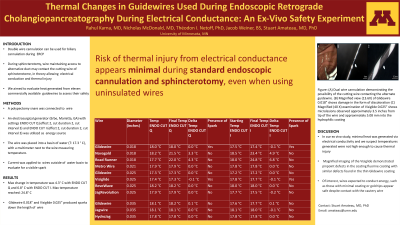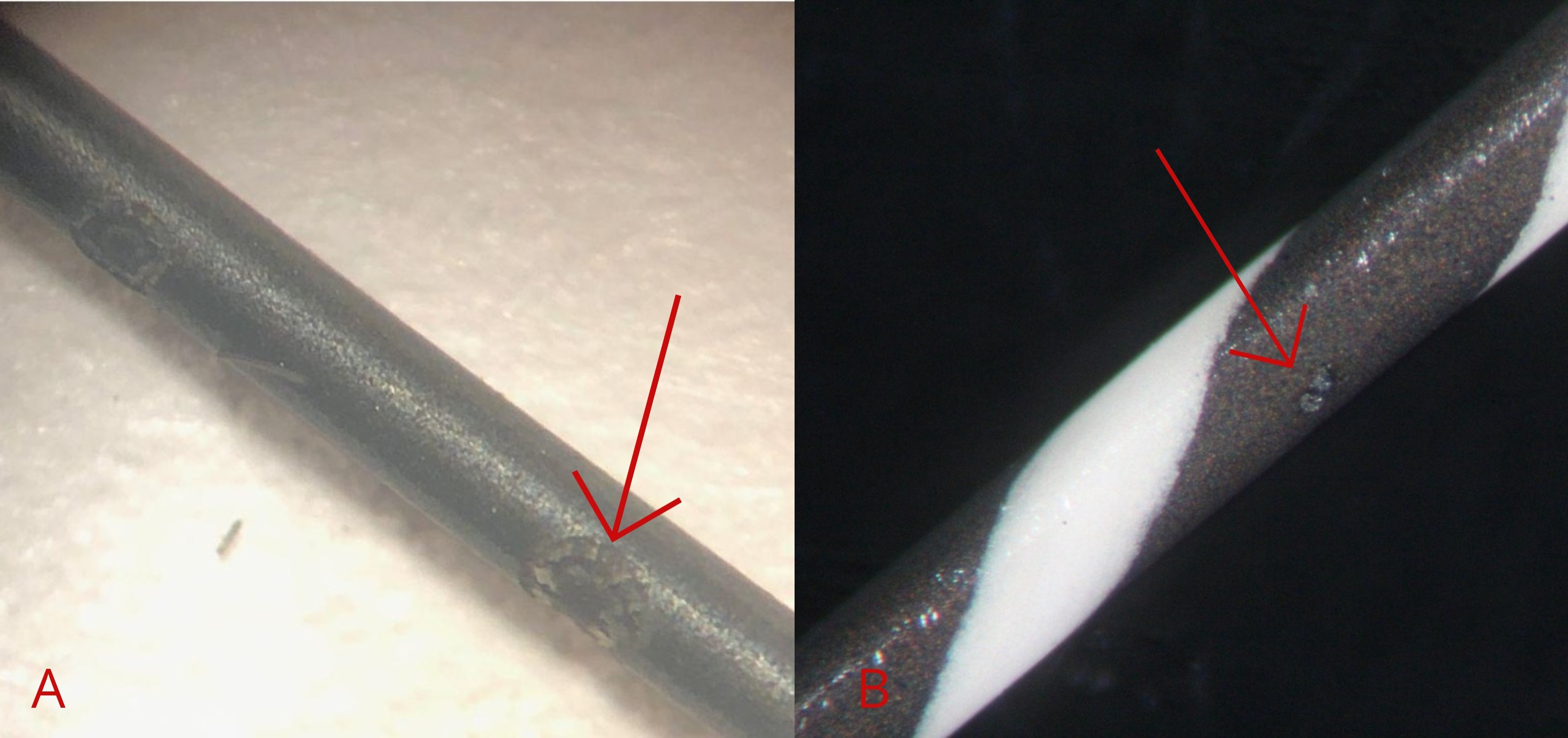Sunday Poster Session
Category: Interventional Endoscopy
P1067 - Thermal Changes in Guidewires Used During Endoscopic Retrograde Cholangiopancreatography During Electrical Conductance: An Ex Vivo Safety Experiment
Sunday, October 27, 2024
3:30 PM - 7:00 PM ET
Location: Exhibit Hall E

Has Audio
- RK
Rahul Karna, MD
University of Minnesota Medical Center
Minneapolis, MN
Presenting Author(s)
Rahul Karna, MD1, Nicholas McDonald, MD2, Théoden I. Netoff, PhD3, Jacob Weiner, BS4, Stuart K. Amateau, MD, PhD, FACG1
1University of Minnesota Medical Center, Minneapolis, MN; 2Thomas Jefferson University, Philadelphia, PA; 3University of Minnesota, Minneapolis, MN; 4University of Minnesota Medical School, Minneapolis, MN
Introduction: Double wire cannulation can be used for biliary cannulation during endoscopic retrograde cholangiopancreatography (ERCP). During sphincterotomy, the wire maintaining access to the alternative duct may come into contact with the cutting wire of the sphincterotome, in theory allowing electrical conduction and thermal injury. Similarly, during endoscopic ampullectomy, snare may contact the guidewire with a wire guided approach. We aimed to evaluate heat generated from the commercially available guidewires to assess safety.
Methods: We tested the heat generation of eleven wires used in ERCP: Glidewire 0.018”, Glidewire 0.025”, Glidewire 0.035” (Terumo Interventional Systems, Somerset, NJ), Metro Wire 0.021” (Cook Medical, Bloomington, IN), Visiglide 0.025” (Olympus, Center Valley, PA), Revowave 0.025” (Olympus, Center Valley, PA), Novagold 0.018” (Boston Scientific, Marlborough, MA), Jagwire 0.035” (Boston Scientific, Marlborough, MA), JagRevolution 0.025” (Boston Scientific, Marlborough, MA), Hydrojag 0.035” (Boston Scientific, Marlborough, MA ), Road Runner 0.018” (Cook Medical, Bloomington, IN). A polypectomy snare was connected to the wire. An Erbe electrosurgical generator (Erbe, Marietta, GA) with settings ENDO CUT Q (effect 2, cut duration 2, cut interval 3) and ENDO CUT I (effect 2, cut duration 2, cut interval 3) was utilized as the energy source. Then the wire was placed into a basin of water (initial temperature: 17.3 ° C), with a multimeter next to the wire measuring temperature. We also applied current to the wires outside of the basin of water to evaluate for a visible spark.
Results: Eleven wires were tested for heat generated and for the presence of a spark from electrical conductance via an electrical surgical generator (Table 1). The max change in temperature was 4.3° C with ENDO CUT Q settings and 6.8° C with ENDO CUT I settings. Despite this change, the max temperature reached was 24.8° C. Two wires: Glidewire 0.018” and Visiglide 0.025” produced large sparks down the length of the wire.
Discussion: In our ex vivo study, minimal heat was generated via electrical conductivity and we suspect temperatures generated were not high enough to cause thermal injury. Magnified imaging of the Visiglide demonstrated pinpoint defects in the coating fluorine coating with similar defects found in the thin Glidewire coating. (Figure 1) Of interest, wires expected to conduct energy, such as those with minimal coating or gold tips appear safe despite contact with the cautery wire.

Note: The table for this abstract can be viewed in the ePoster Gallery section of the ACG 2024 ePoster Site or in The American Journal of Gastroenterology's abstract supplement issue, both of which will be available starting October 27, 2024.
Disclosures:
Rahul Karna, MD1, Nicholas McDonald, MD2, Théoden I. Netoff, PhD3, Jacob Weiner, BS4, Stuart K. Amateau, MD, PhD, FACG1. P1067 - Thermal Changes in Guidewires Used During Endoscopic Retrograde Cholangiopancreatography During Electrical Conductance: An Ex Vivo Safety Experiment, ACG 2024 Annual Scientific Meeting Abstracts. Philadelphia, PA: American College of Gastroenterology.
1University of Minnesota Medical Center, Minneapolis, MN; 2Thomas Jefferson University, Philadelphia, PA; 3University of Minnesota, Minneapolis, MN; 4University of Minnesota Medical School, Minneapolis, MN
Introduction: Double wire cannulation can be used for biliary cannulation during endoscopic retrograde cholangiopancreatography (ERCP). During sphincterotomy, the wire maintaining access to the alternative duct may come into contact with the cutting wire of the sphincterotome, in theory allowing electrical conduction and thermal injury. Similarly, during endoscopic ampullectomy, snare may contact the guidewire with a wire guided approach. We aimed to evaluate heat generated from the commercially available guidewires to assess safety.
Methods: We tested the heat generation of eleven wires used in ERCP: Glidewire 0.018”, Glidewire 0.025”, Glidewire 0.035” (Terumo Interventional Systems, Somerset, NJ), Metro Wire 0.021” (Cook Medical, Bloomington, IN), Visiglide 0.025” (Olympus, Center Valley, PA), Revowave 0.025” (Olympus, Center Valley, PA), Novagold 0.018” (Boston Scientific, Marlborough, MA), Jagwire 0.035” (Boston Scientific, Marlborough, MA), JagRevolution 0.025” (Boston Scientific, Marlborough, MA), Hydrojag 0.035” (Boston Scientific, Marlborough, MA ), Road Runner 0.018” (Cook Medical, Bloomington, IN). A polypectomy snare was connected to the wire. An Erbe electrosurgical generator (Erbe, Marietta, GA) with settings ENDO CUT Q (effect 2, cut duration 2, cut interval 3) and ENDO CUT I (effect 2, cut duration 2, cut interval 3) was utilized as the energy source. Then the wire was placed into a basin of water (initial temperature: 17.3 ° C), with a multimeter next to the wire measuring temperature. We also applied current to the wires outside of the basin of water to evaluate for a visible spark.
Results: Eleven wires were tested for heat generated and for the presence of a spark from electrical conductance via an electrical surgical generator (Table 1). The max change in temperature was 4.3° C with ENDO CUT Q settings and 6.8° C with ENDO CUT I settings. Despite this change, the max temperature reached was 24.8° C. Two wires: Glidewire 0.018” and Visiglide 0.025” produced large sparks down the length of the wire.
Discussion: In our ex vivo study, minimal heat was generated via electrical conductivity and we suspect temperatures generated were not high enough to cause thermal injury. Magnified imaging of the Visiglide demonstrated pinpoint defects in the coating fluorine coating with similar defects found in the thin Glidewire coating. (Figure 1) Of interest, wires expected to conduct energy, such as those with minimal coating or gold tips appear safe despite contact with the cautery wire.

Figure: Illustration of Glidewire (A) and Visiglide (B) with defects seen at high magnification (40 X)
Note: The table for this abstract can be viewed in the ePoster Gallery section of the ACG 2024 ePoster Site or in The American Journal of Gastroenterology's abstract supplement issue, both of which will be available starting October 27, 2024.
Disclosures:
Rahul Karna indicated no relevant financial relationships.
Nicholas McDonald indicated no relevant financial relationships.
Théoden Netoff indicated no relevant financial relationships.
Jacob Weiner indicated no relevant financial relationships.
Stuart Amateau: Boston Scientific – Consultant. Cook – Consultant. Merit – Consultant. Olympus – Advisory Committee/Board Member. Provation – Advisory Committee/Board Member. Steris – Consultant.
Rahul Karna, MD1, Nicholas McDonald, MD2, Théoden I. Netoff, PhD3, Jacob Weiner, BS4, Stuart K. Amateau, MD, PhD, FACG1. P1067 - Thermal Changes in Guidewires Used During Endoscopic Retrograde Cholangiopancreatography During Electrical Conductance: An Ex Vivo Safety Experiment, ACG 2024 Annual Scientific Meeting Abstracts. Philadelphia, PA: American College of Gastroenterology.
